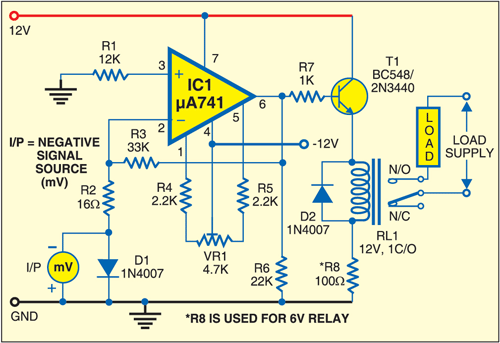 Common electromagnetic relays with coil voltage of 5V, 6V or 12V can operate power circuits in the range of 250 to 300 volts and up to 20A. The actuating current of these relays is in the range of 50 to 100 mA. In many applications, such as temperature-controlled equipment, energisation / de-energisation of 5V, 6V or 12V relays for ‘on’/‘off’ control of the load is to be achieved by a few millivolts.
Common electromagnetic relays with coil voltage of 5V, 6V or 12V can operate power circuits in the range of 250 to 300 volts and up to 20A. The actuating current of these relays is in the range of 50 to 100 mA. In many applications, such as temperature-controlled equipment, energisation / de-energisation of 5V, 6V or 12V relays for ‘on’/‘off’ control of the load is to be achieved by a few millivolts.

Here is a simple relay actuating circuit that can be used to energise relays with a few millivolts as the input. As shown in the figure, the circuit is built around op-amp µA741(IC1) followed by an emitter follower using transistor 2N3440 (T1) and a few discrete components. You can change the sensitivity required (when the input is in millivolts range) to energise the relay by changing the value of resistors R1, R2 and R3. In all the cases, values of R4, R5 and R6 remain unchanged.
Resistor R8 is basically a current-limiting resistor used in series with the relay coil. This resistor is not required with a 12V, 200-ohm relay. This circuit can be used to drive 24V relays, by changing the supply voltage to ±18V. To get the best results, using preset VR1 adjust the offset at pin 4 of the op-amp to as low a value as possible.
The working of the circuit is simple. When a few millivolts (say, 200 mV) are applied at the input terminal shown in the diagram, the output of IC1 at pin 6 goes high and transistor T1 conducts to energise relay RL1. As a result, the load gets power supply through normally-open (N/O) contacts of the relay.
Assemble the circuit on a general-purpose PCB and enclose in a suitable cabinet. Connect the relay carefully so that the contact can handle the load current.
Do not use resistor R8 with 9V or 12V relays. In this case, connect the junction of the anode of D2 and the coil of the relay to ground.



